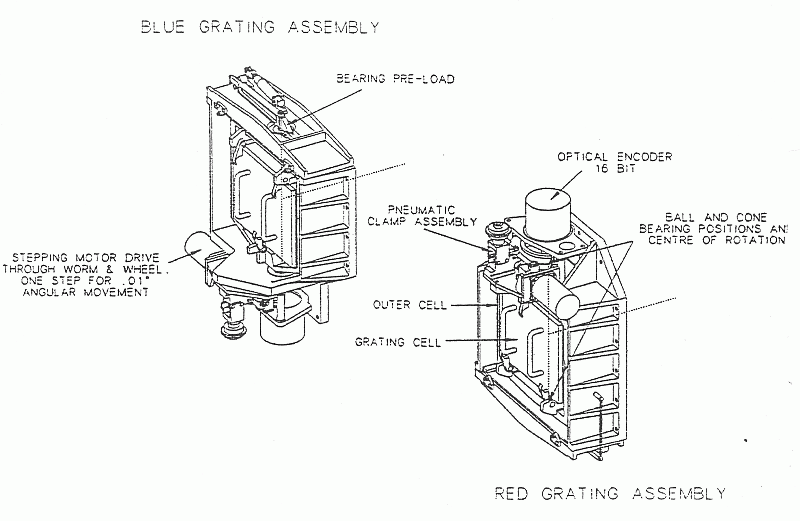 are for this configuration.
are for this configuration.




Nine gratings are provided for ISIS, four for the red arm and five for the blue arm. The first letter of the grating name denotes the method of manufacture, eight of the nine gratings are copies of ruled masters manufactured by Milton Roy, whilst H2400B is a holographic grating manufactured by Jobin Yvon. The number denotes the number of lines per millimeter. The last letter of the name indicates which arm of ISIS it is intended for; those ending in B are intended for the blue arm, and those ending in R for the red arm. However the grating cells are identical, and all gratings will mount in either arm. All gratings have a ruled area of 154 x 206 mm. Grating R1200B was ruled in two halves; this can be seen quite easily if the grating is held up to the light.
Gratings can be used either blaze to collimator or blaze to camera.
Use blaze to camera gives somewhat higher dispersion, but as the
anamorphic reduction factor is reversed this is at the
expense of a greatly reduced slit to plate reduction factor, especially
at high dispersions. The ISIS
gratings are almost invariably used blaze to collimator, and the slit
widths given in table  are for this configuration.
are for this configuration.
Table  gives the parameters of the gratings, and the pixel
size and spectral range obtained with EEV and Tektronix CCDs (22.5 and 24
micron pixels respectively) and for the blue gratings with the CCD-IPCS
(10.5 micron pixels). The final column in the table below gives the slit
width in arcseconds which will project to 50
gives the parameters of the gratings, and the pixel
size and spectral range obtained with EEV and Tektronix CCDs (22.5 and 24
micron pixels respectively) and for the blue gratings with the CCD-IPCS
(10.5 micron pixels). The final column in the table below gives the slit
width in arcseconds which will project to 50  m on the detector.
m on the detector.

Table: ISIS grating properties
There is also a single silver coated plane mirror in a grating cell, originally intended for alignment purposes, but which can be used in place of the gratings for direct imaging at a plate scale of 14.9 arcsec/mm. To use the mirrors for imaging they should be mounted in the grating cells, which should then be set to the autocollimation angles. The autocollimation angles are 35500 millidegrees for the red arm and 30800 millidegrees for the blue arm.
The grating cell angles are driven by a stepper motor from the ISIS 4ms microprocessor, and their positions are encoded by Ferranti 35HA optical absolute encoders. The units for these mechanisms are millidegrees, and the encoders are accurate to 3 millidegrees, and repeatable to 2 millidegrees. The grating angle offsets are grating independent.

[ TIFF ]
Figure: The ISIS Grating Cells



